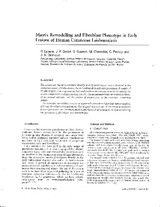| dc.description.abstract | SUMMARY.
The connective matrix participates directly in early pathological events observed in the
cutaneous lesion of leishmaniasis, due to Leishmania braziliensis guyanensis. A sample of
19 skin biopsies was examined by light and electron microscopy, in order to identify the
matrix components (collagen isotypes I to lV, elastin and membrane associated proteins)
of the dermal infiltrate, and the pattern of organization of the reparative connective
matrix.
An extensive remodelling process of apparently parasite-independent nature involves
different fibroblast sub-populations. The original organization of this immune-mediated
lesion offers a rare opportunity to study in situ the local inflammatory mediators inducing
the activation of fibroblasts and macrophages. | es_ES |

